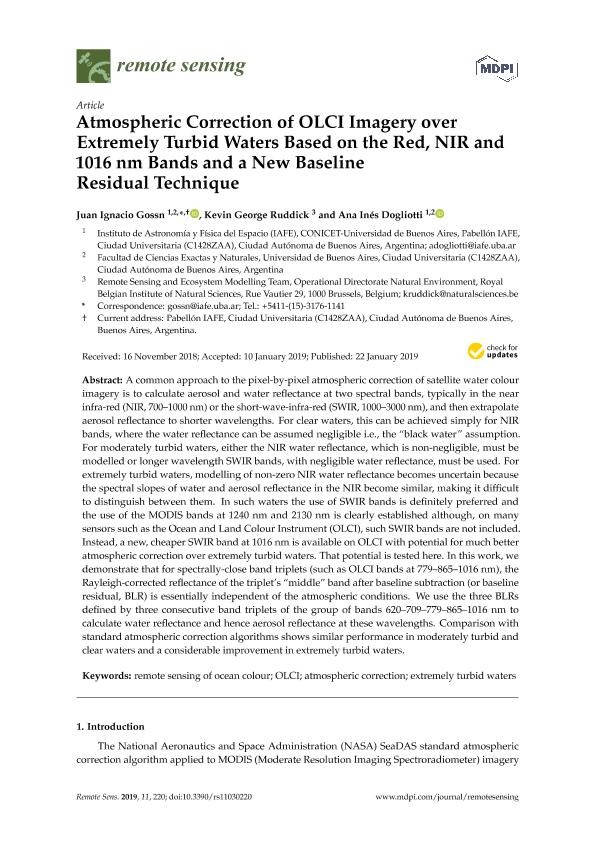Mostrar el registro sencillo del ítem
dc.contributor.author
Gossn, Juan Ignacio

dc.contributor.author
Ruddick, Kevin George
dc.contributor.author
Dogliotti, Ana Inés

dc.date.available
2023-08-14T15:15:51Z
dc.date.issued
2019-02
dc.identifier.citation
Gossn, Juan Ignacio; Ruddick, Kevin George; Dogliotti, Ana Inés; Atmospheric correction of OLCI imagery over extremely turbid waters based on the red, NIR and 1016 nm bands and a new baseline residual technique; MDPI AG; Remote Sensing; 11; 3; 2-2019; 1-24
dc.identifier.issn
2072-4292
dc.identifier.uri
http://hdl.handle.net/11336/208163
dc.description.abstract
A common approach to the pixel-by-pixel atmospheric correction of satellite water colour imagery is to calculate aerosol and water reflectance at two spectral bands, typically in the near infra-red (NIR, 700-1000 nm) or the short-wave-infra-red (SWIR, 1000-3000 nm), and then extrapolate aerosol reflectance to shorter wavelengths. For clear waters, this can be achieved simply for NIR bands, where the water reflectance can be assumed negligible i.e., the "black water" assumption. For moderately turbid waters, either the NIR water reflectance, which is non-negligible, must be modelled or longer wavelength SWIR bands, with negligible water reflectance, must be used. For extremely turbid waters, modelling of non-zero NIR water reflectance becomes uncertain because the spectral slopes of water and aerosol reflectance in the NIR become similar, making it difficult to distinguish between them. In such waters the use of SWIR bands is definitely preferred and the use of the MODIS bands at 1240 nm and 2130 nm is clearly established although, on many sensors such as the Ocean and Land Colour Instrument (OLCI), such SWIR bands are not included. Instead, a new, cheaper SWIR band at 1016 nm is available on OLCI with potential for much better atmospheric correction over extremely turbid waters. That potential is tested here. In this work, we demonstrate that for spectrally-close band triplets (such as OLCI bands at 779-865-1016 nm), the Rayleigh-corrected reflectance of the triplet's "middle" band after baseline subtraction (or baseline residual, BLR) is essentially independent of the atmospheric conditions. We use the three BLRs defined by three consecutive band triplets of the group of bands 620-709-779-865-1016 nm to calculate water reflectance and hence aerosol reflectance at these wavelengths. Comparison with standard atmospheric correction algorithms shows similar performance in moderately turbid and clear waters and a considerable improvement in extremely turbid waters.
dc.format
application/pdf
dc.language.iso
eng
dc.publisher
MDPI AG
dc.rights
info:eu-repo/semantics/openAccess
dc.rights.uri
https://creativecommons.org/licenses/by/2.5/ar/
dc.subject
ATMOSPHERIC CORRECTION
dc.subject
EXTREMELY TURBID WATERS
dc.subject
OLCI
dc.subject
REMOTE SENSING OF OCEAN COLOUR
dc.subject.classification
Otras Ciencias de la Tierra y relacionadas con el Medio Ambiente

dc.subject.classification
Ciencias de la Tierra y relacionadas con el Medio Ambiente

dc.subject.classification
CIENCIAS NATURALES Y EXACTAS

dc.title
Atmospheric correction of OLCI imagery over extremely turbid waters based on the red, NIR and 1016 nm bands and a new baseline residual technique
dc.type
info:eu-repo/semantics/article
dc.type
info:ar-repo/semantics/artículo
dc.type
info:eu-repo/semantics/publishedVersion
dc.date.updated
2019-12-18T13:54:58Z
dc.journal.volume
11
dc.journal.number
3
dc.journal.pagination
1-24
dc.journal.pais
Suiza

dc.description.fil
Fil: Gossn, Juan Ignacio. Consejo Nacional de Investigaciónes Científicas y Técnicas. Oficina de Coordinación Administrativa Ciudad Universitaria. Instituto de Astronomía y Física del Espacio. - Universidad de Buenos Aires. Facultad de Ciencias Exactas y Naturales. Instituto de Astronomía y Física del Espacio; Argentina
dc.description.fil
Fil: Ruddick, Kevin George. Belgian Institute of Natural Sciences; Bélgica
dc.description.fil
Fil: Dogliotti, Ana Inés. Consejo Nacional de Investigaciónes Científicas y Técnicas. Oficina de Coordinación Administrativa Ciudad Universitaria. Instituto de Astronomía y Física del Espacio. - Universidad de Buenos Aires. Facultad de Ciencias Exactas y Naturales. Instituto de Astronomía y Física del Espacio; Argentina
dc.journal.title
Remote Sensing
dc.relation.alternativeid
info:eu-repo/semantics/altIdentifier/url/http://www.mdpi.com/2072-4292/11/3/220
dc.relation.alternativeid
info:eu-repo/semantics/altIdentifier/doi/http://dx.doi.org/10.3390/rs11030220
Archivos asociados
